Vad är symbios?
Med symbios menas att två olika arter lever tillsammans. Oftast brukar man säga att båda arterna måste tjäna på det för att det ska kallas symbios, men egentligen stämmer inte det. När båda arter tjänar på samarbetet kallas symbiosen för ”mutualistisk”. Ett vanligt exempel är symbios mellan växter och insekter. Insekter besöker blommor och fruktträd för att äta nektar. När de kryper ner i blomman får de också med sig pollen som fastnar på deras kroppar eller ben. När de sedan flyger vidare till nästa blomma av samma art, sprider de pollen och hjälper blommor och fruktträd med fortplantningen.
En blomfluga med pollenkorn som fastnat på kroppen - ett exempel på symbios mellan insekter och växter.
Bild: Andre-Karwath-CC-BY-SA
Ett bi med fyllda pollensäckar på benen. Samarbetet mellan pollinerande insekter och växter kallas för mutualistiskt, eftersom både växt och insekt tjänar på samarbetet.
Bild: Marc-Andrighetti-CC-BY-SA
Bladskärarmyrorna skär loss bitar av löv och bär till sitt bo...
...för att mata den svamp myrorna odlar i boet. Genom att odla svampen, får också myrorna tillgång till mat.
Bild: Christian-R.-Linder-CC-BY-SA
Trädrötter med mykorrhiza - ett samarbete mellan träd och svampar.
Bild: Wilhelm-Zimmerling-CC-BY-SA
Gruppen orkidéer är helt beroende av samarbete med svampar för att överleva.
Bild: Jose-Manuel-Lopez-Pinto-CC-BY-SA
Vi människor lever i symbios med många av de bakterier som finns i och på vår kropp. Vi har bakterier i munnen och tarmarna som hjälper till med att bryta ner näringsämnen som proteiner, fett och kolhydrater. I näsan och på huden skyddar de mot farliga mikroorganismer.
Svampar i många samarbeten
Vissa myror och svamparter lever i symbios. Bladskärarmyran samlar in blad till sitt bo. Bladen blir till mat åt den svamp som lever i boet. Bladskärarmyrorna äter i sin tur av svampen. Växter och svampar lever ofta i symbios. Växtens rötter och svampens svamptrådar (mycel) byter vatten och näringsämnen med varandra. Detta kallas för mykorrhiza. Vissa växter, som orkideer, är helt beroende av mykorrhiza för att överleva.
Clownfisken har ett skyddande slemlager på huden, som gör den immun mot anemonens gift. Anemonen ett perfekt skydd för clownfisken, eftersom rovdjur helst håller sig borta. Clownfisken håller rent hos anemonen, genom att äta upp dess matrester, parasiter, och fläkta friskt vatten över anemonens tentakler.
Bild: Alexander-Vasenin-CC-BY-SA
De flesta arter av pistolräkor lever i symbios med fiskar i familjen smörbultar, eller gobys. Eftersom räkan har så dålig syn, håller fisken vakt, medan räkan med sina praktiska klor gräver ur bohålan. Både fisken och räkan tjänar på samarbetet.
Bild: Steve-Childs-CC-BY
Eremitkräftan samarbetar med små havsanemoner. De skyddar kräftan mot rovdjur, samtidigt som de får skjuts på skalet och får större chans att få i sig mat.
Bild: Nick-Hobgood-CC-BY-SA
Clownfisken och anemonen, pistolräkan och gobyn
Clownfisken, som du kanske sett i filmen Hitta Nemo, lever i symbios med havsanemoner. Den är immun mot anemonens gift, och lever skyddad från rovfiskar som inte tål giftet. Clownfisken lever också på rester av anemonens måltider. Clownfisken skyddar i sin tur havsanemonen från parasiter, och rovdjur som vill äta den.
Pistolräkan och gobyn har också ett nära samarbete. Pistolräkan skottar sand ur det gemensamma boet, med sina stora klor. Under tiden håller gobyn vakt. En viktig symbios för pistolräkan som har dålig syn men är en utmärkt skottare, och för gobyn som knappast kan gräva, men är duktig på att hålla vakt!
Huvudlusen lever som parasit i människors hårbotten där den suger blod.
Bild: Gilles-San-Martin-CC-BY-SA
Binnikemaskar är parasitmaskar som lever i tarmarna på människor och andra ryggradsdjur.
Bild: Diphyllobothrium_Ta-Ntalas-CC-BY-SA
En nyckelpiga som vaktar en parasitstekelkokong.
Bild: Gilles-San-Martin-CC-BY-SA
Tungbitaren är en fiskparasit som tar sig in genom fiskens gälar och stryper blodtillförseln till fiskens tunga så att den trillar av. Sedan ersätter parasiten tungan, och lever i fiskens mun genom att suga blod och äta slem från fisken.
Bild: Marco-Vinci-CC-BY-SA
En myra som dött av en parasitsvampinfektion.
Bild: Bernard-DUPONT-CC-BY-SA
Zombiemyror och inälvsmaskar
En annan form av symbios är parasitism. Då är det bara den ena arten som drar nytta av symbiosen, och den andra missgynnas genom att skadas, få svårt att fortplanta sig eller till och med dö. En del parasiter finns på utsidan av kroppen – som löss, fästingar och loppor. Andra finns inuti kroppen, som inälvsparasiter och binnikemask.
Det finns en parasitstekel som lägger sina ägg inuti nyckelpigor. Larverna äter av nyckelpigans kropp utan att skada inre organ. Larverna spinner sedan en kokong under nyckelpigan och får den att vakta kokongen tills larverna kläckts
Det finns flera sporsäckssvampar som parasiterar på insekter och myror. Parasitsvampens sporer tar sig in i myrans kropp och ändrar myrans beteende så att den klättar upp i ett högt träd där den biter sig fast. Sedan dör myran och svampen tränger sig ut ur myrkroppen och sprider sina sporer till nya myror. Ju högre upp svampen släpper sina sporer desto lättare är det att infektera fler myror.

Vanlig clownfisk
Amphiprion ocellaris
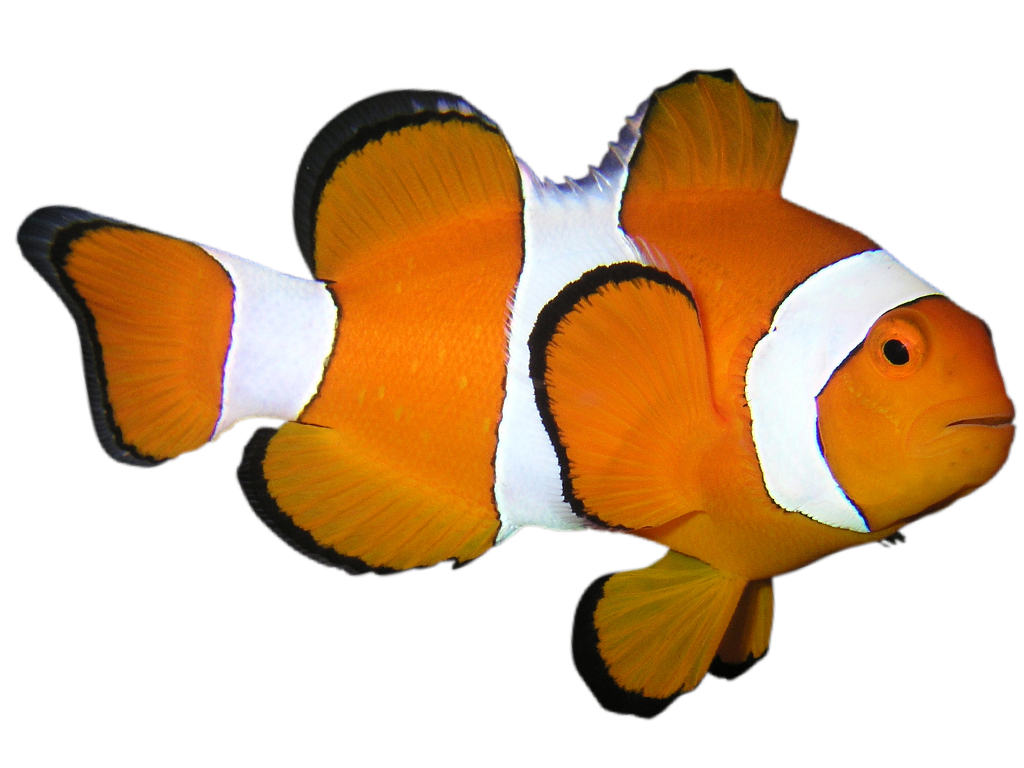
Samarbetar med den giftiga anemonen
Kanske känner du igen de orange-vita fiskarna som simmar bland anemonens tentakler? Det är arten vanlig clownfisk, som är den fisk som blivit känd från filmen Hitta Nemo. Anemonens tentakler innehåller nässelceller, som avger ett gift som skadar andra fiskar. Men inte clownfisken! Den har ett skyddande slemlager på huden, som gör den immun mot anemonens gift. Därför är anemonen ett perfekt skydd för clownfisken, eftersom rovdjur helst håller sig borta.
Men det är inte bara clownfisken som tjänar på samarbetet. Clownfisken håller rent hos anemonen, genom att äta upp dess matrester, parasiter, och fläkta friskt vatten över anemonens tentakler. När två olika arter lever tillsammans i ett nära förhållande, kallas det för symbios.

Bild: Alexander-Vasenin-CC-BY-SA
Honan bestämmer i gruppen
Den vanliga clownfisken lever i korallrev i små grupper. I gruppen finns bara en hona, hon är störst och högst i rang. Den största hanen är hennes partner, ofta livet ut. Han är den enda som får fortplanta sig. Honan stör sin manliga partner så pass att han inte blir lika stor som henne. Resten av fiskarna i gruppen är yngre eller mindre hanar.
Den stora hanen utsätter de mindre hanarna för samma beteende som honan utsätter honom för. Det gör att de inte heller får tag på så mycket mat att de kan växa sig stora. När clownfiskar förökar sig lägger honan många ägg på en sten nära anemonen, som hanen vaktar till de kläcks. Efter några dagar som larver, som driver omkring fritt i vattnet, söker sig ynglen till en egen anemon att leva i.

Bild: Prilfish-CC-BY
Nemos pappa borde blivit Nemos mamma
Alla clownfiskar föds, och utvecklas, som hanar. Det enda sättet för en ny hona att utvecklas är när den förra honan i en grupp av någon anledning försvinner. Då byter den största kvarvarande hanen kön och blir dominant hona. Den största ungfisken blir ny dominant hanne. I filmen Hitta Nemo har Nemos mamma dött. Hade det varit i verkligheten, hade Nemos pappa därför blivit Nemos nya mamma!
Efter filmen Hitta Nemo, blev clownfiskar väldigt populära som akvariefiskar. De fiskas därför i stora mängder, men många nybörjare vet inte hur man ska ta hand om ett saltvattensakvarium. Ännu är inte den vanliga clownfisken rödlistad, men mycket tyder på att den kommer att bli det i framtiden.
Utbredningsområde i världen
Korallrev i östra Indiska oceanen och västra Stilla havet.
Vit markering = Utbredningsområde.

Hotstatus enligt Rödlistan

Reglerad inom handel
CITES: Ej listad.

Pistolräka
Alpheidae sp.
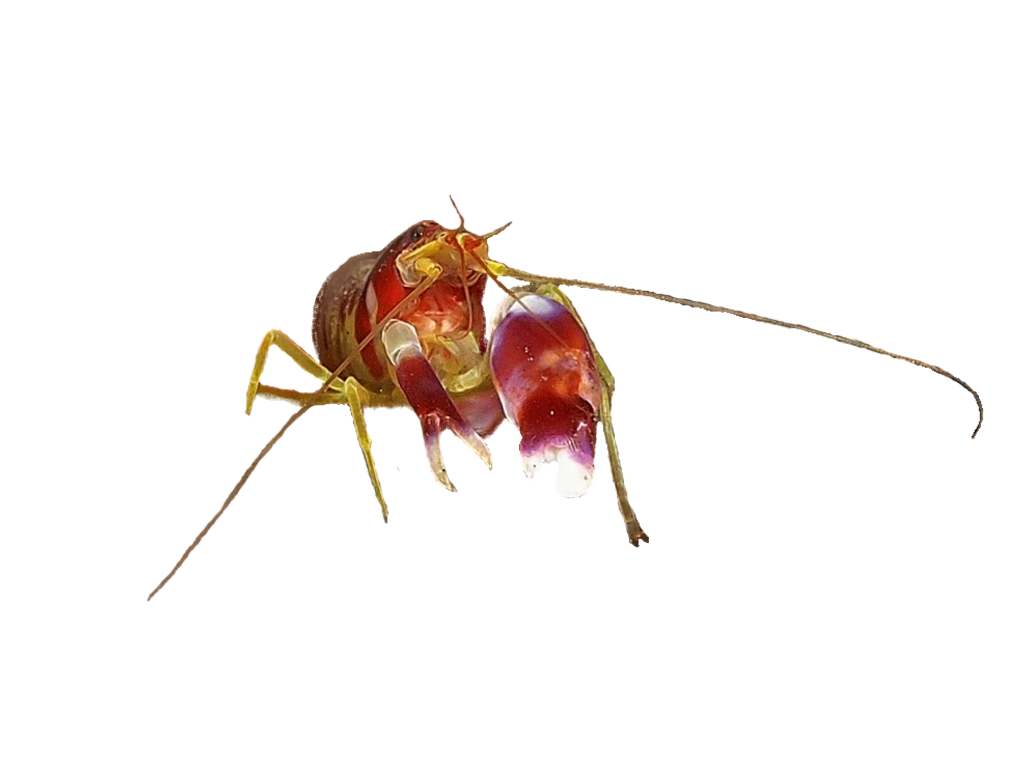
Mycket skarpt ljud av klon
Pistolräkor är en familj av räkor som består av ungefär 600 arter. Gemensamt för alla pistolräkor är att ena klon är kraftigt förstorad, och kan slås ihop med ett pistolskottsliknande ljud på upp till 218 decibel. Det är ljudnivåer som kan mäta sig med valar, som är världens mest högljudda djur. När pistolräkan slår ihop sin klo, bildas en tryckvåg som är så stark, att den kan paralysera fiskar och andra bytesdjur.
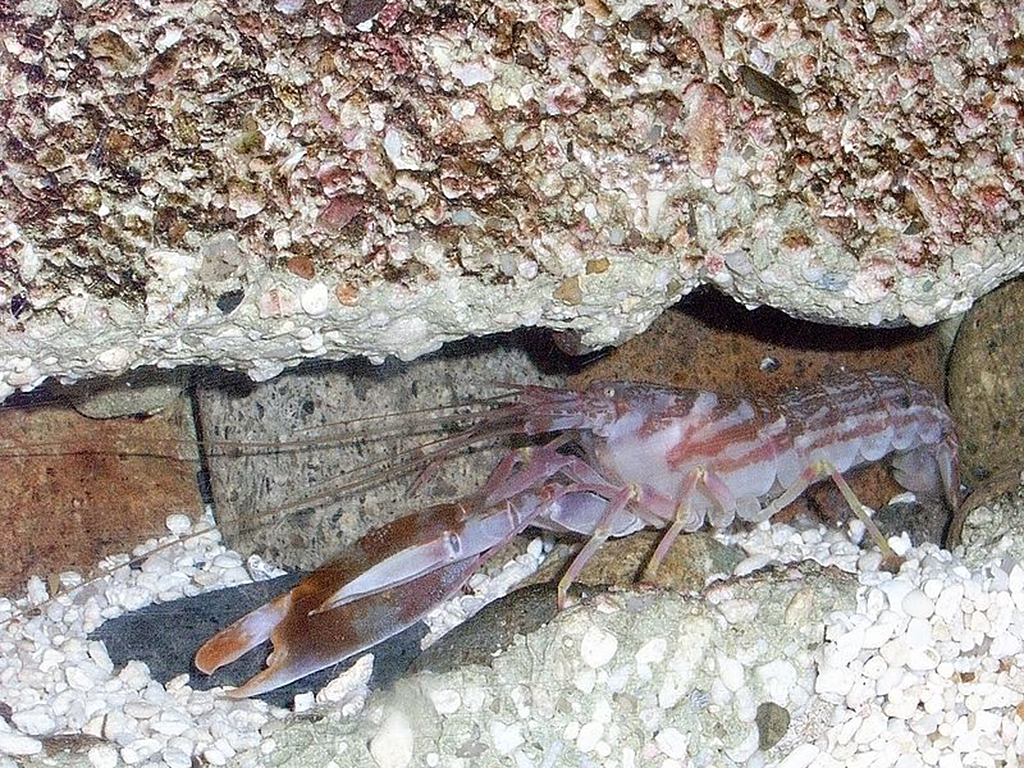
Bild: Daiju-Azuma-CC-BY-SA
Bygger bo åt beskyddande fisk
Pistolräkan har ett mycket hårt skal, långa antenner på huvudet och 10 ben. Om den förlorar sin stora klo, växer den mindre klon ut till en stor klo. Förlorar den sin lilla klo, växer det ut en ny. Pistolräkor har mycket dålig syn, med små ögon som täcks över av ryggskölden.
Pistolräkor är bottenlevande och gräver hålor i sanden, gärna under stenar eller korallrev. De flesta arter av pistolräkor lever i symbios med fiskar i familjen smörbultar, eller gobys. Eftersom räkan har så dålig syn, håller fisken vakt, medan räkan med sina praktiska klor gräver ur bohålan. Både fisken och räkan tjänar på samarbetet.
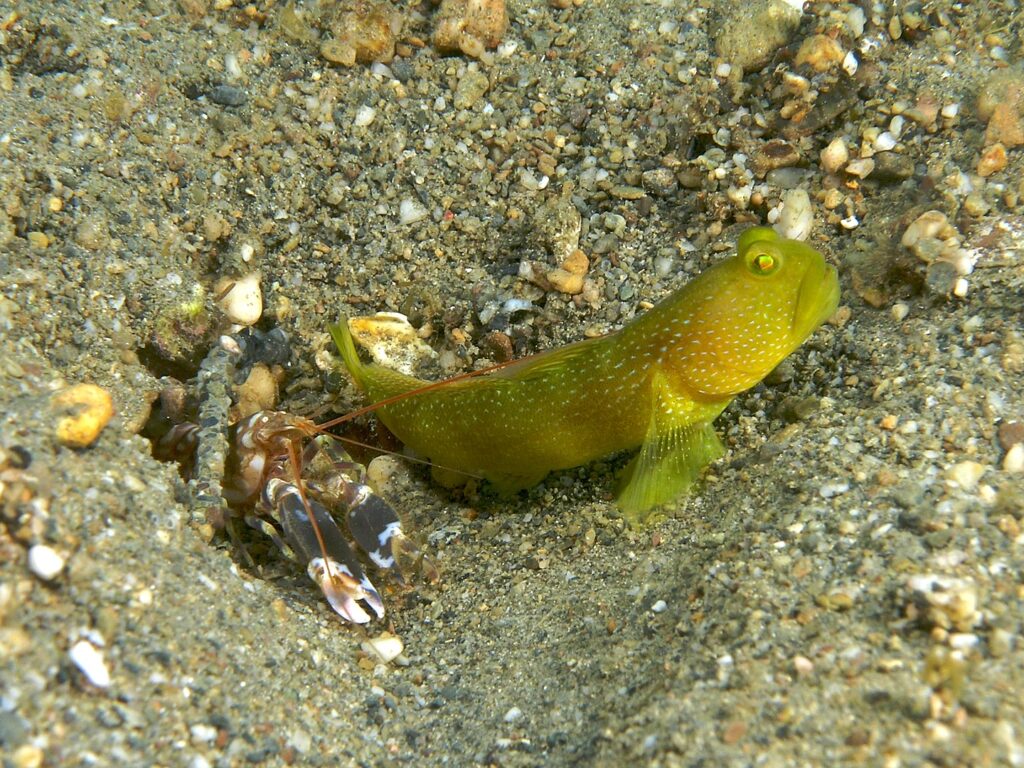
Bild: Nhobgood-Nick-CC-BY-SA
Kan vara tvåkönade
Vissa arter av pistolräkor är hermafroditer – alltså att samma individ kan vara både hane och hona, men av andra arter finns både hanar och honor. Ett par av pistolräkor kan hålla ihop hela livet, och även tvåkönade arter bildar par för att inom paret utvecklas till en hona och en hane. Pistolräkor lägger sina ägg i kammare i hålorna de gräver.
Utbredningsområde i världen
Östra Stilla havet i korallrev runt ekvatorn.

Hotstatus enligt Rödlistan

Reglerad inom handel
CITES: Ej listad.

Juvelblennid
Salarias fasciatus
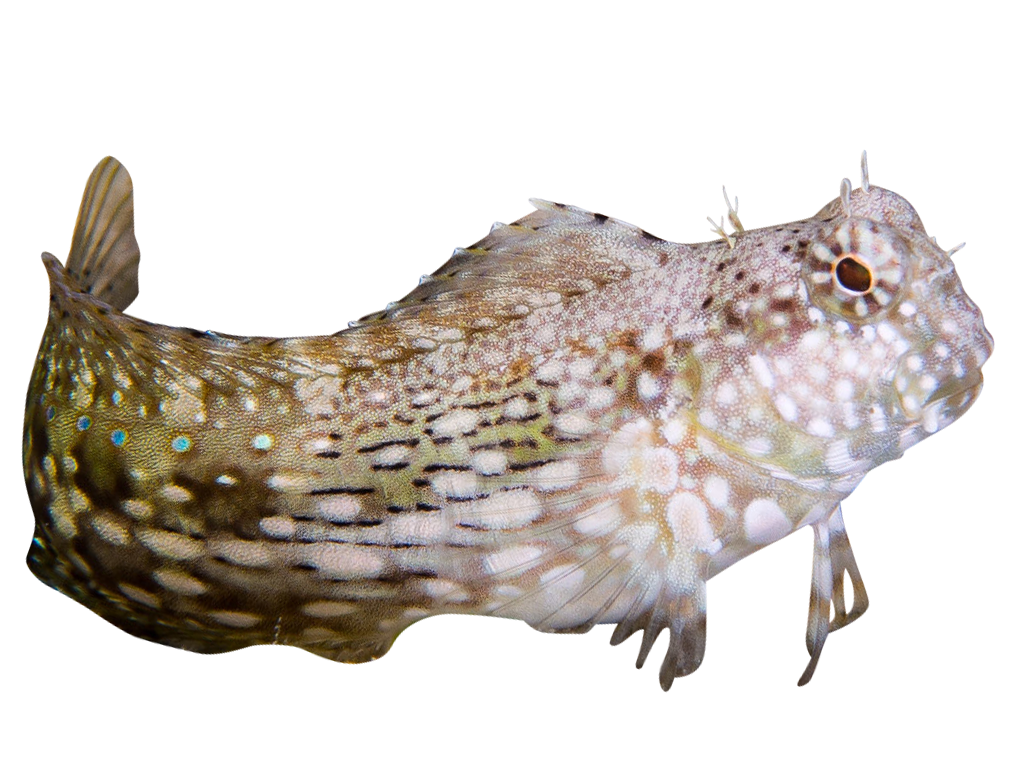
Äter förmultnande djur
Juvelblennid tillhör familjen blennider, som också kallas för slemfiskar. Gruppen slemfiskar har gemensamt att deras kroppar är täckta av en hinna av tjockt slem. Hinnan gör att fiskarna kan överleva kortare stunder ovanför vattenytan.
Juvelblenniden livnär sig på en blandning av att plocka alger, äta avföring och förmultnade delar av döda djur. Fisken lever i korallrev, ofta i grunda laguner och stillastående vatten, nära sandig botten. Arten lever ensam eller i par. Den anpassar sin färg till livsmiljön och kan byta färg för att gömma sig för rovdjur.
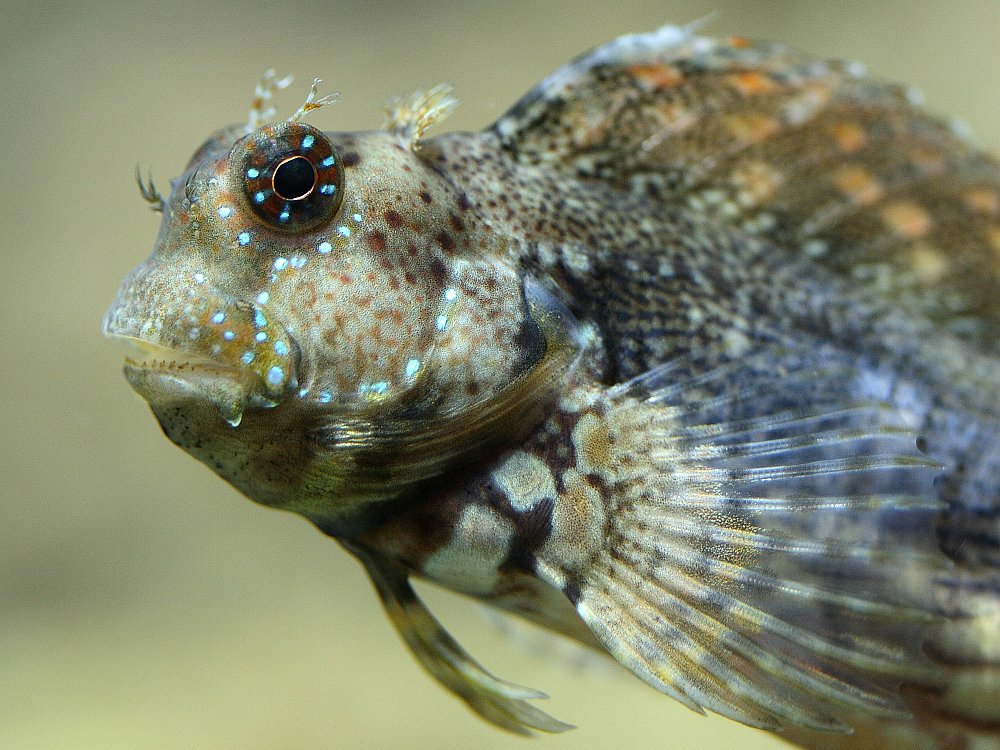
Bild: Dirk-Godlinski-CC-BY-SA
Honan fäster ägg på växter
Vuxna hanar av juvelblennid har en förlängd analfena. De försvarar aggressivt revir, och när det inte är parningssäsong är hanarna aggressiva mot honorna. Men under parningssäsongen får hanen orangea fläckar på ryggfenan, och han gör en dans för honan. Han fäller upp fenorna och gungar med hela kroppen.
Honan lägger ägg som fästs fast på växter som växer på stenar eller direkt på botten, och hanen befruktar äggen där. Arten är en populär akvariefisk som gärna äter alger från akvariets inredning och glasrutor.
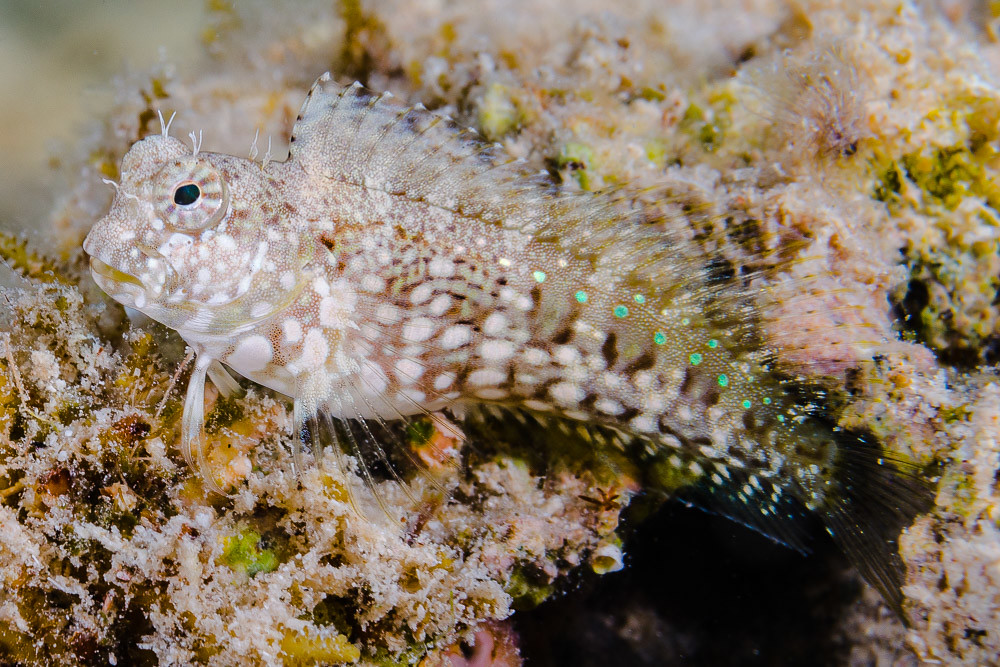
Bild: zsispeo-CC-BY-NC-SA
Utbredningsområde i världen

Från Östra Afrika till Indonesien, Fiji, Salomonöarna, söder om Stora Barriärrevet.
Hotstatus enligt Rödlistan

Reglerad inom handel
CITES: Ej listad.

Sjögräsfilfisk
Acreichthys tomentosus
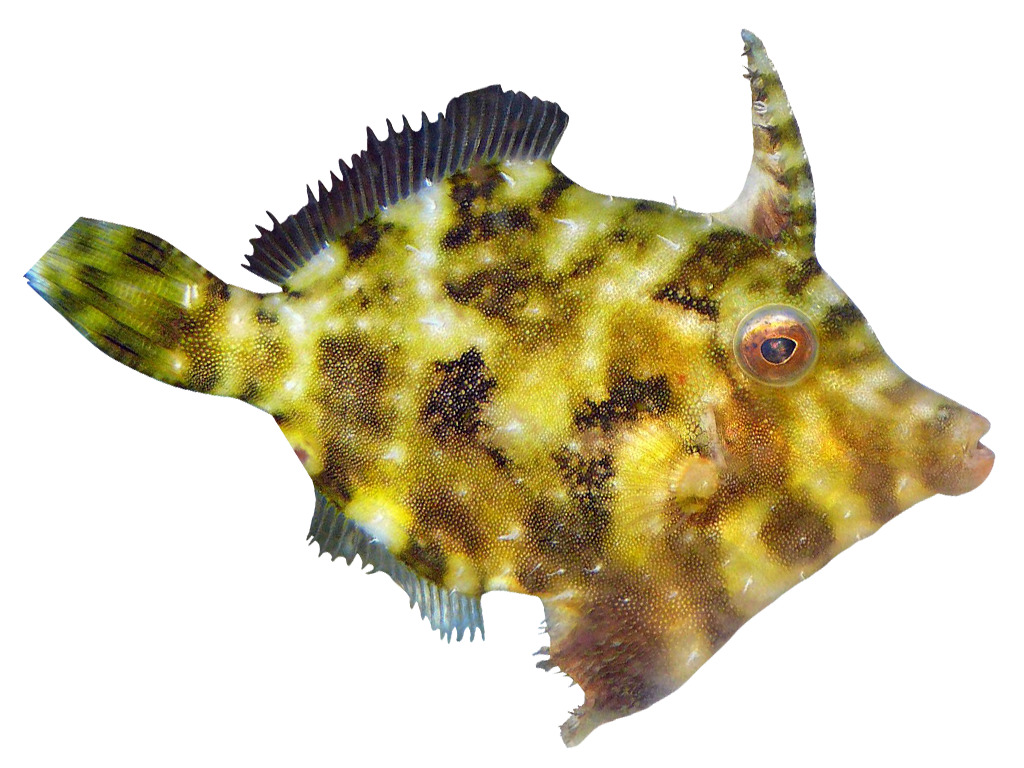
Huden är sträv och kan ändra färg
Sjögräsfilfisken tillhör gruppen filfiskar som fått sitt namn efter den kompakta kroppen och att huden är sträv likt sandpapper. Den kan även ändra färg på kroppen efter vilken miljö den lever i. Detta hjälper filfisken att undvika rovdjur. Arten är skygg och lever i tropiska grunda vatten bland sjögräs. Sjögräsfilfisken är en omtyckt akvariefisk, mestadels för att den är bra på att äta glasrosor. Glasrosor är en sorts koralldjur, som ofta ställer till problem i akvarium. Filfisken fungerar alltså som ett nyttodjur och städpersonal i akvariet.
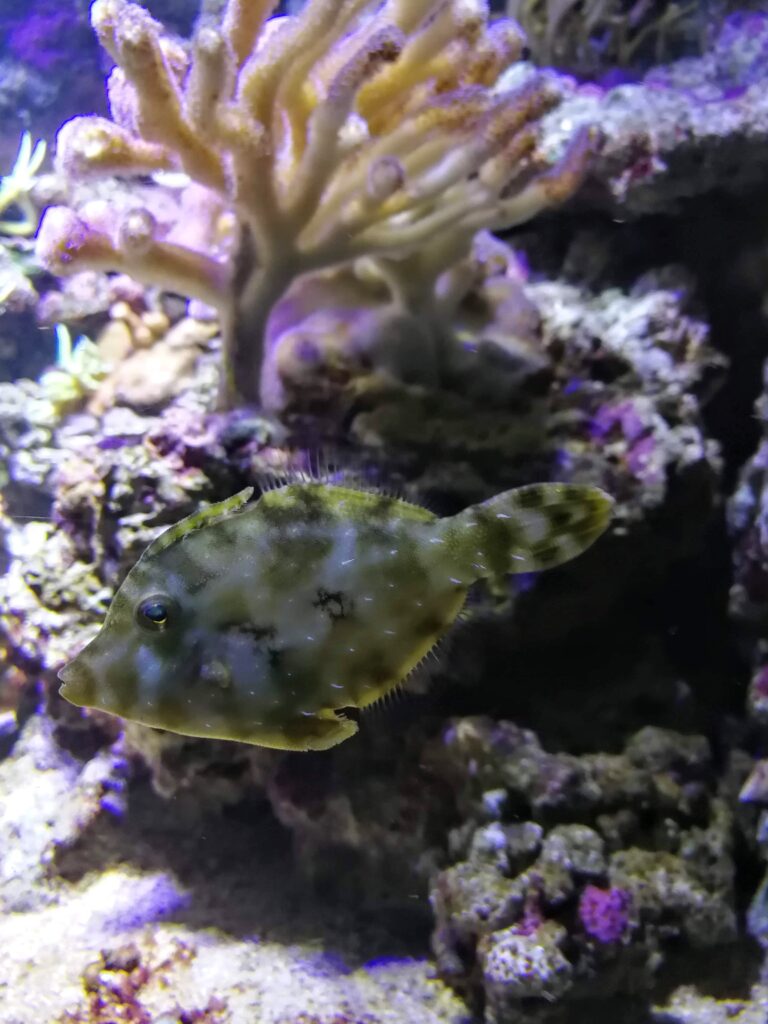
Bild: Ellika-Nordström-Malmö-Museer
En tagg på ryggen
Sjögräsfilfisken har ett karakteristiskt utseende med en kraftig tagg med en hudflik på ryggfenan. Taggen kan resas upp och gör att fisken ser större ut. Hanen reser upp taggen, både mot andra hanar och för att locka till sig en partner. En hona kan lägga flera hundra ägg som hon försvarar mot andra fiskar. När äggen har kläckts får ynglen klara sig på egen hand.
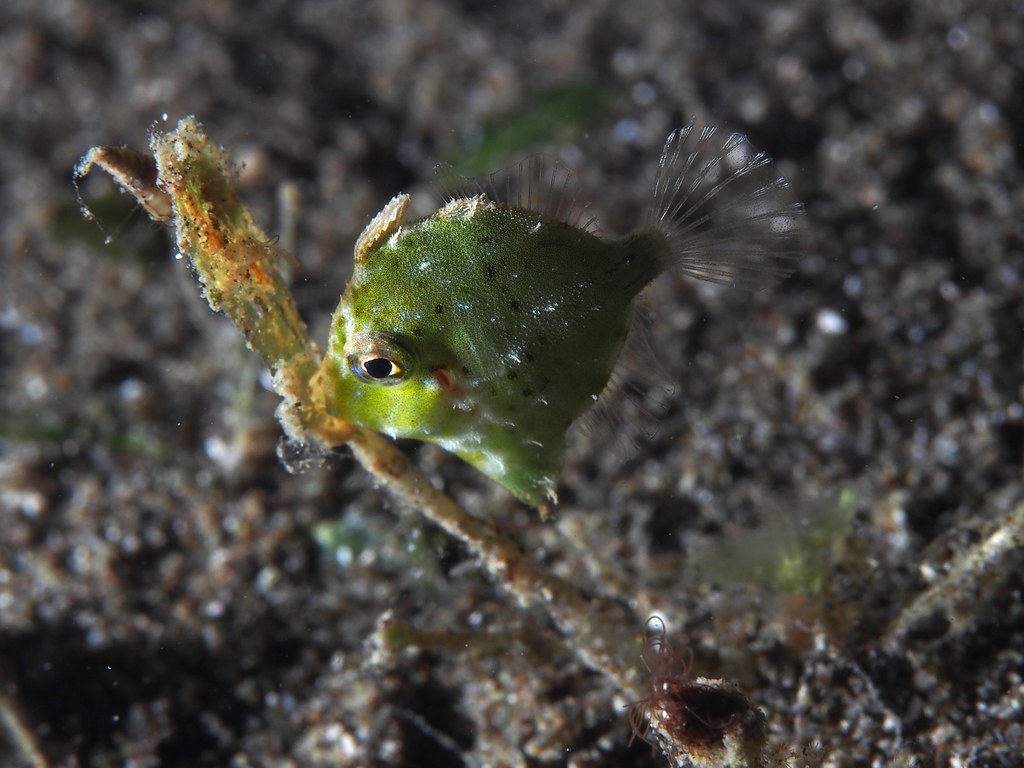
Bild: krokodiver-CC-BY-SA
Utbredningsområde i världen

Främst i Indiska oceanen och västra Stilla havet.
Hotstatus enligt Rödlistan

Reglerad inom handel
CITES: Ej listad.

Stenkoraller
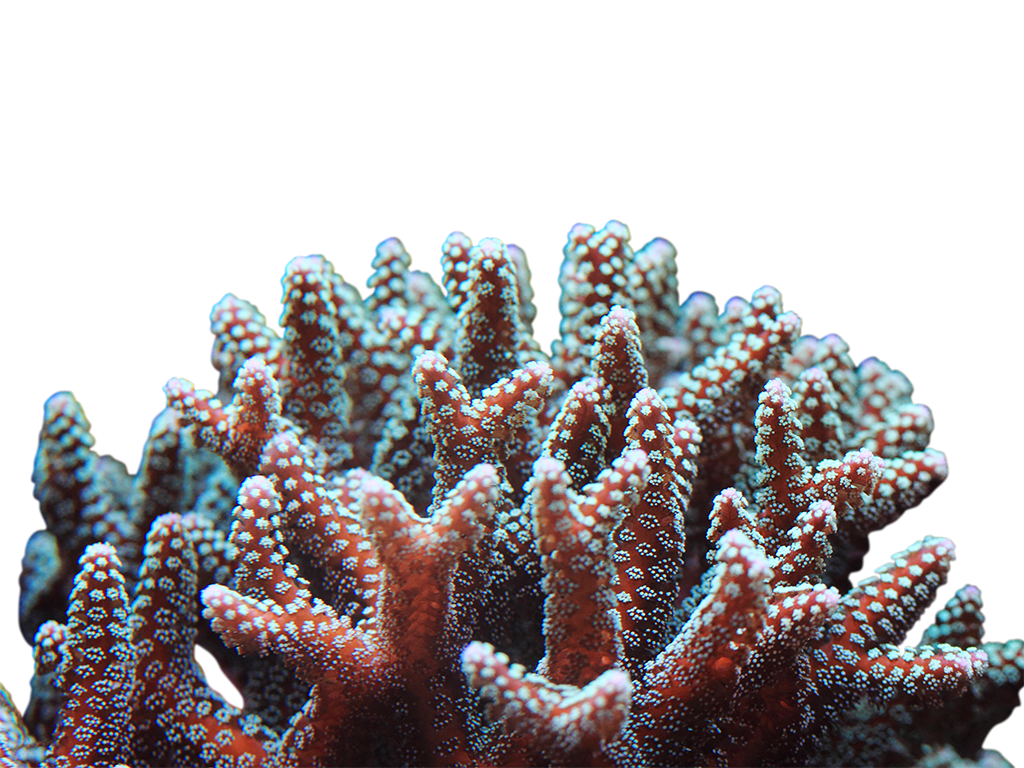
Bygger grunden till korallrev
Stenkoraller har hårda skelett, som de bygger av kalcium de plockar upp från havsvattnet. Korallerna är beroende av hög kalkhalt i vattnet för att få hållbara skelett. Koraller lever i haven över stora delar av jorden. De är vanligast i tropiska vatten, men lever också i svenska vatten utanför Bohuslän.
Stenkoraller har stor betydelse för att bygga upp korallreven, eftersom de bildar hårda kalkskelett som blir kvar även efter korallens död. Stenkoraller kan ha många olika former, som greniga, runda, skivformade eller knöliga. Stenkoraller som lever i kolonier kan till exempel likna en hjärna, eller ett älghorn.
Stenkorallernas hårda skelett är det som utgör grunden för världens korallrev.
Bild: Toby-Hudson-CC-BY-SA
Korallreven innehåller många gömställen för alla möjliga arter.
Bild: Nick-Hobgood-CC-BY-SA
Acroporakoraller kan likna hjortdjurens horn.
Bild: MDC-Seamarc-Maldives-CC-BY-SA
Stenkorall med en yta som påminner om en hjärna.
Bild: Ryan-McMinds-CC-BY
Korallers strukturer kan vara väldigt olika.
Bild: Ryan-McMinds-CC-BY
Stenkoraller kan växa som tickor eller stora sjok med lavar.
Bild: Williams-et-al.-CC-BY
Under de mjuka, långa tentaklerna gömmer sig anemonkorallens hårda kalkskelett.
Bild: Bernard-DUPONT-CC-BY-SA
Svampkoraller i Indonesien.
Bild: Bernard-DUPONT-CC-BY-SA
En kallvattenskorall med spännande växtsätt, som lever på djup ner till 1500 meter.
Ett bulligt, svampigt växtsätt för en stenkorall.
Bild: Diego-Delso-CC-BY-SA
Har alger som inneboende
Stenkoraller tillhör ordningen koralldjur, och det finns ca 2500 arter. En korall är oftast en hel koloni av små polyper, som var och en är en egen individ – ofta kopior av varandra. Polyper har en säckliknande kropp som skyddas av ett yttre kalkskelett. Stenkoraller lever oftast, men inte alltid, i stora kolonier.
Många arter av stenkoraller lever i symbios med så kallade zooxantheller, som är en typ av encelliga alger. Zooxantheller lever inuti polyperna. De bidrar till korallens energiförsörjning, och behöver solljus som når ner genom vattnet för att överleva. Stenkoraller i kolonier är hårdare och tåligare än ensamlevande. Men de stenkoraller som lever ensamma, kan finnas ända ner till 6000 meters djup! Djuplevande koraller får sin näring genom att äta plankton som flyter förbi i vattnet.
Varje polyp är en egen individ, som tillsammans bildar en korallkoloni.
Bild: Peter-Young-Cho-CC-BY-SA
I mitten av polypen sitter koralldjurets mun.
Bild: Justin-Casp-CC-BY-SA
Små polyper som delvis är utfällda.
Bild: David-Witherall-and-Pete-Morrison-CC-BY
Mikroskopiskt små polyper med fångstarmar.
Bild: Narrissa-Spies-CC-BY-SA
En polyp som alldeles nyss fäst mot ett underlag. De bruna prickarna är korallens inneboende alger, zooxantheller.
Bild: Narrissa-Spies-CC-BY-SA
Zooxantheller kallas de alger som är de vanligaste inneboenden i koraller. Här i mikroskop.
Bild: Tim-Wijgerde-CC-BY-SA

Havsanemoner
Actiniaria

Djur som liknar svamp eller växt
Havsanemonerna kanske ser ut som växter eller svampar, men är en ordning av vattenlevande djur inom gruppen nässeldjur. I nässeldjuren ingår också anemonens släktingar, som koraller och maneter. Havsanemoner finns i många olika färger, som rött, rosa, gult, vitt, orange, grönt, blått och brunt. Vanligtvis har de en storlek med en diameter runt 1 till 5 centimeter och är mellan 1 och 10 centimeter höga. Men eftersom de är uppblåsbara och kan expandera varierar de mycket i storlek. Det finns anemoner som kan nå en diameter och längd på över 1 meter när de är fullt expanderade.
De flesta havsanemoner lever vid de tropiska reven, men det finns en del arter som även anpassat sig till kallare vatten med sandmiljöer och tidvattenrev. På hela jorden finns ungefär 1200 arter av anemoner, och ca 30 av dessa går att hitta längs den svenska västkusten.
Havsanemoner kan likna blommor under vattnet.
Havsanemoner känns igen på de långa tentaklerna. De är täckta med nässelceller som används för att paralysera och fånga byten.
Bild: Sergey-Galyonkin-CC-BY-SA
Grön anemon med lila toppar.
Anemoner kan vara svarta.
En lila havsanemon.
En anemon med "bubblor" i ändarna av tentaklerna.
Bild: Blowing-Puffer-Fish-CC-BY
Små anemoner som kallas jordgubbsanemoner.
Bild: Peter-Southwood-CC-BY-SA
Havsanemoner kan vara randiga.
Bild: Peter-Southwood-CC-BY-SA
Röda havsanemoner som dragit in sina tentakler under lågvatten. Arten finns längs Norges kust.
Bild: O.-Nevestveit-CC-BY-SA
Flikfotsanemonen är en art av havsanemon som finns i svenska vatten, längs västkusten.
Bild: Mike-Noren-CC-BY-SA
Äter och bajsar genom samma hål
Anemoner är byggda på ett sätt som kallas för polyper. De är formade som cylindrar (rör), och består av en kropp, en fot och en krona med tentakler. I kroppen finns en hålighet, som en säck, som fungerar som anemonens mage. Till magen leder ett hål, som både är mun och anus. Anemonens många tentakler rör sig fram och tillbaka i vattnet. På tentaklerna sitter brännande nässelceller som dels skyddar mot rovdjur, dels förlamar och fångar in byten som räkor och plankton. Maten flyttas med hjälp av tentaklerna till munnen.
Fotplattan på undersidan av anemonens kropp använder den för att sätta fast sig, på stenar, tång eller liknande nära botten. Några arter är dock helt frisimmande i vattnet. Fotplattan växer inte fast vid underlaget, utan anemonen kan flytta sig. Men förflyttningar sker i extremt långsamt tempo.
I mitten av anemonen sitter djurets mun, som är samma hål som anemonen också bajsar från.
Bild: Daniel-Ankele-CC-BY-SA
På tentaklerna sitter havsanemonens nässelceller, som bränns och kan förlama ett byte.
Bild: prilfish-CC-BY
En havsanemon som fångat och äter en fisk.
De brännande nässelcellerna kan användas till att slåss med andra anemoner eller koraller, för att få den bästa platsen. Här syns två anemoner som bränt hål på varandras tentakler.
Bild: Seascapeza-CC-BY-SA
Arten vandrande havsanemon är extra flyttbar, och kan "vandra" runt på bottnen efter den bästa platsen.
Bild: Peter-Southwood-CC-BY-SA
Här syns undersidan av havsanemonens fot, mot en glasruta.
Bild: Betty-Wills-CC-BY-SA
Havsanemoner kan föröka sig genom att släppa ut könsceller i vattnet, men också genom att dela sig, som på den här bilden.
Havsanemoner som kamouflerat sig med sandkorn.
Brännande tentakler nytta för andra arter
Många anemoner lever i symbios, alltså samarbete, med andra arter som fiskar, krabbor och alger. Fiskarna får skydd mot rovdjur av anemonernas brännande tentakler. Clownfiskar, känd från filmen Hitta Nemo, har utvecklat ett speciellt slemlager i huden som skyddar mot giftet i anemonernas tentakler. Anemonen får fördelen att få mat, genom att äta bitar av småfisk, alger och maskar som lämnats som matrester från clownfisken.
En del anemoner lever i symbios med krabbor och fäster sig fast på deras skal med hjälp av sin fotplatta. Anemonen skyddar krabborna mot rovdjur och får i utbyte föda, genom att äta krabbans matrester.
Många arter av clownfiskar har ett nära samarbete med havsanemoner. Fisken är immun mot havsanemonens gift och får ett perfekt gömställe.
Bild: Rizalubun-CC-BY-SA
Eremitkräftan samarbetar med små havsanemoner. De skyddar kräftan mot rovdjur, samtidigt som de får skjuts på skalet och får större chans att få i sig mat.
Bild: Nick-Hobgood-CC-BY-SA

Sandstjärna
Archaster typicus
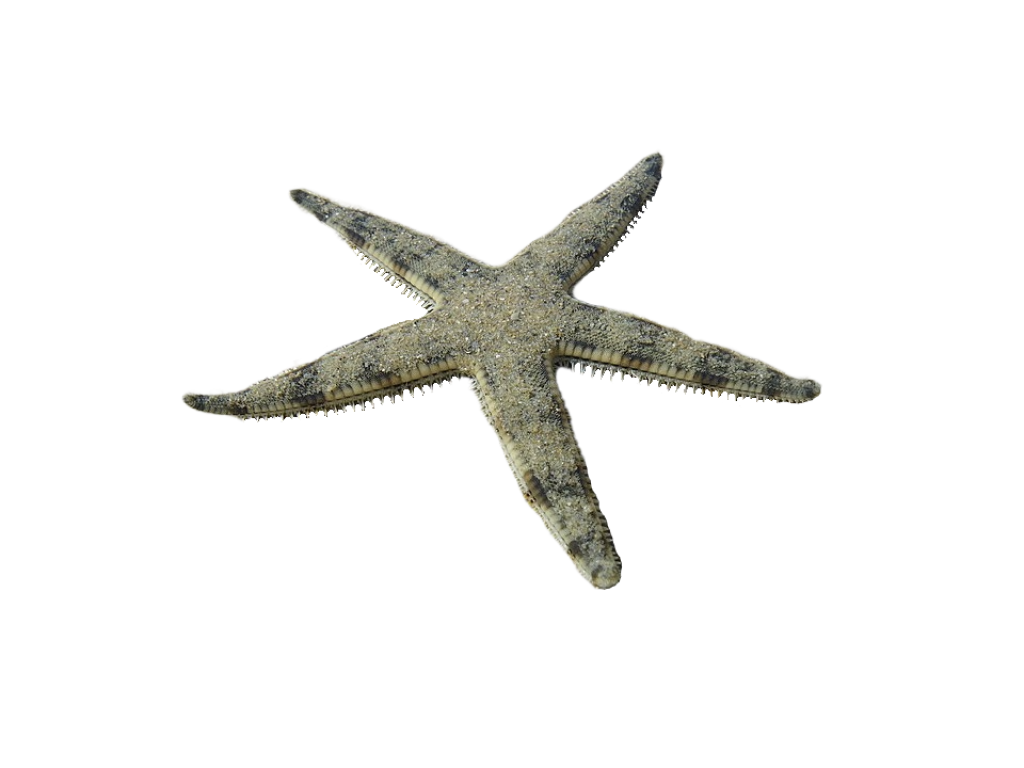
Ögon i armarna och magen utanför kroppen
När sjöstjärnor äter slingrar de armarna om sitt byte, till exempel en mussla, och bänder upp det. Sjöstjärnans matsmältningssystem är enkelt, och munnen sitter på undersidan. När sjöstjärnan äter ett större byte kan den stjälpa ut sin mage utanför kroppen och fånga in och även smälta bytet, fortfarande med magen utanför kroppen.
Om någon av sjöstjärnans armar förloras växer en ny ut. Ytterst på varje arm har sjöstjärnan ett öga. Ögonen kan urskilja ljusskillnader. På varje arm finns också en könskörtel, som kallas gonad, som producerar könsceller och könshormoner. Sjöstjärnor har inte någon centraliserad hjärna, men ändå ett avancerat nervsystem, och de är känsliga för beröring. Hjärtat hos en sjöstjärna slår bara ca sex gånger per minut.
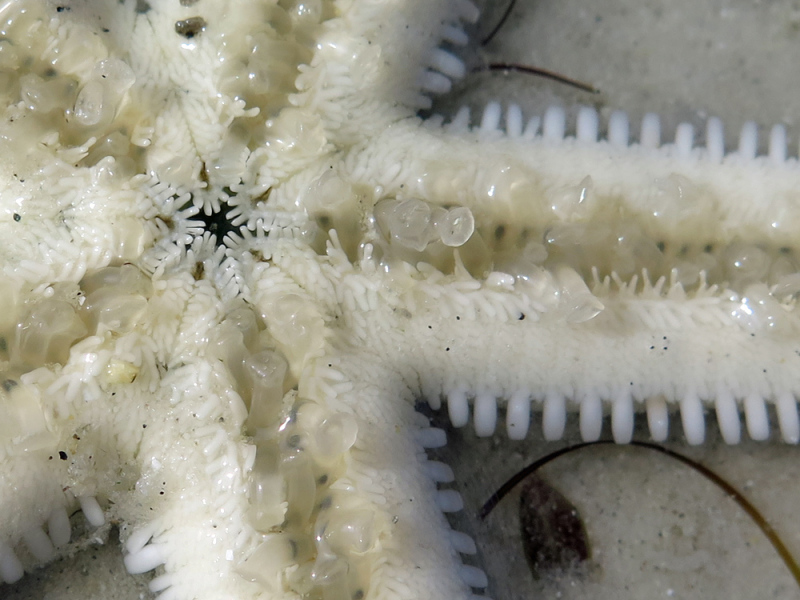
Bild: Anne-Hoggett-CC-BY
En tagghuding
Sjöstjärnor tillhör ordningen tagghudingar. Det finns totalt 2000 arter, och där ingår bland annat sjöborrar, ormstjärnor och sjöstjärnor som till exempel sandstjärnan. Sandstjärnan har oftast fem armar, men kan ha fler eller färre. De ligger ofta delvis nedgrävda i sanden. Arten har minskat i antal, och i början av 2000-talet dog ett stort antal utanför Singapore, på grund av förlust av livsmiljöer och att de fiskades upp.
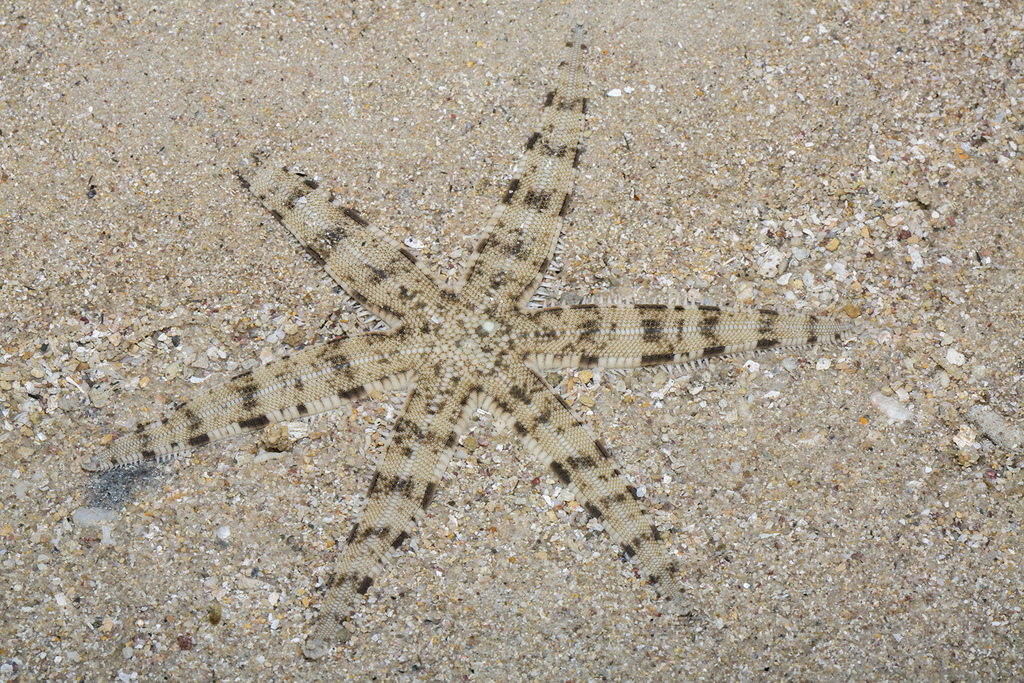
Bild: budak-CC-BY-NC
Hanen ligger på honans rygg i månader
De flesta sjöstjärnor förökar sig genom att helt enkelt släppa ut ägg och spermier fritt i vattnet, utan att hanen och honan har någon egentlig fysisk kontakt. Men sandstjärnor är lite annorlunda! Hanen, som är mindre än honan, söker upp en hona under parningssäsongen och lägger sig ovanpå henne. Han kan stanna i det läget upp till två månader! När det är dags för parning slingrar de ihop armarna. Könsorganen möts inte, utan hanen avger sperma och honan ägg som sedan befruktas fritt ute i vattnet. Ungarna växer upp vid sjögräs och rötter ovan havsbotten, nära sandiga stränder.
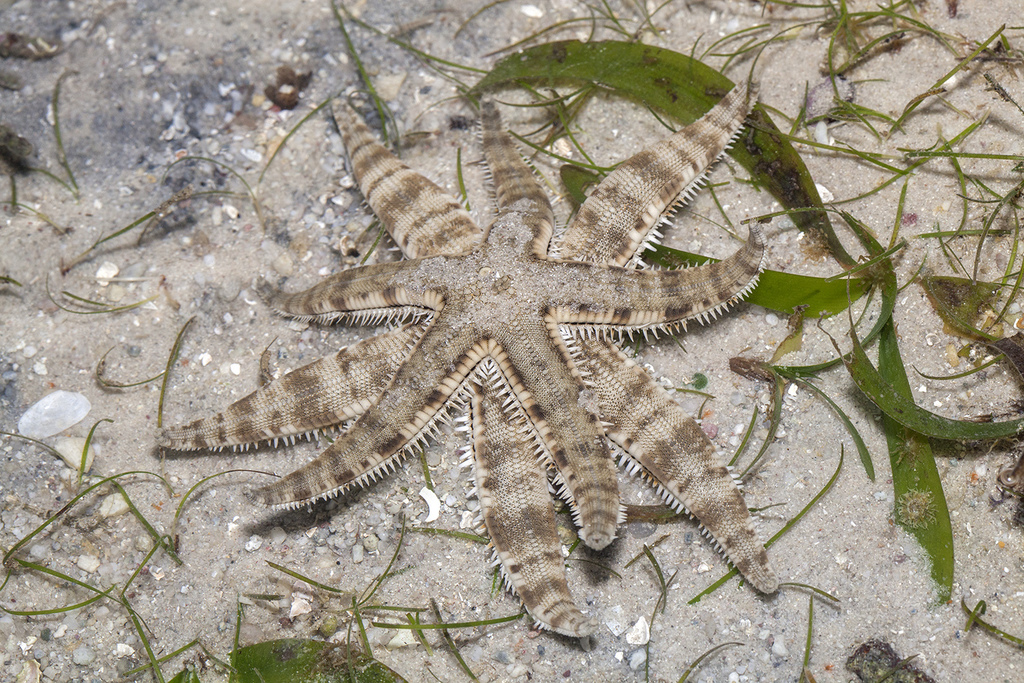
Bild: budak-CC-BY-NC
Utbredningsområde i världen
Stillahavsområdet.

Hotstatus enligt Rödlistan

Reglerad inom handel
CITES: Ej listad.

Vad är Rödlistan?
Rödlistning är ett sätt att bedöma om olika djur- och växtarter är utrotningshotade utifrån kriterier som hur många djur eller växter som finns av arten och hur utbredda de är. En nationell rödlistning bedömer artens risk att dö ut inom ett lands gränser. Den internationella rödlistningen bedömer artens risk att dö ut över hela jorden.
Läs mer

Om rödlistning i Sverige: Artdatabanken, www.artdatabanken.se
Om rödlistning i världen: International Union for Conservation of Nature, IUCN, www.iucn.org

Vad är CITES?
För att bekämpa olaglig handel med djur och växter finns en internationell överenskommelse om handel, som heter CITES. CITES innebär att utrotningshotade djur och växter inte får köpas eller säljas mellan olika länder utan tillstånd.
CITES klassar olika arter i olika kategorier (som kallas Appendix I, II och III) beroende på hur hotad arten är. Ju större hotet från handeln är desto högre skydd. Inom EU finns ytterligare skydd för arter i CITES. EU:s egen klassning har fyra steg: A-D.
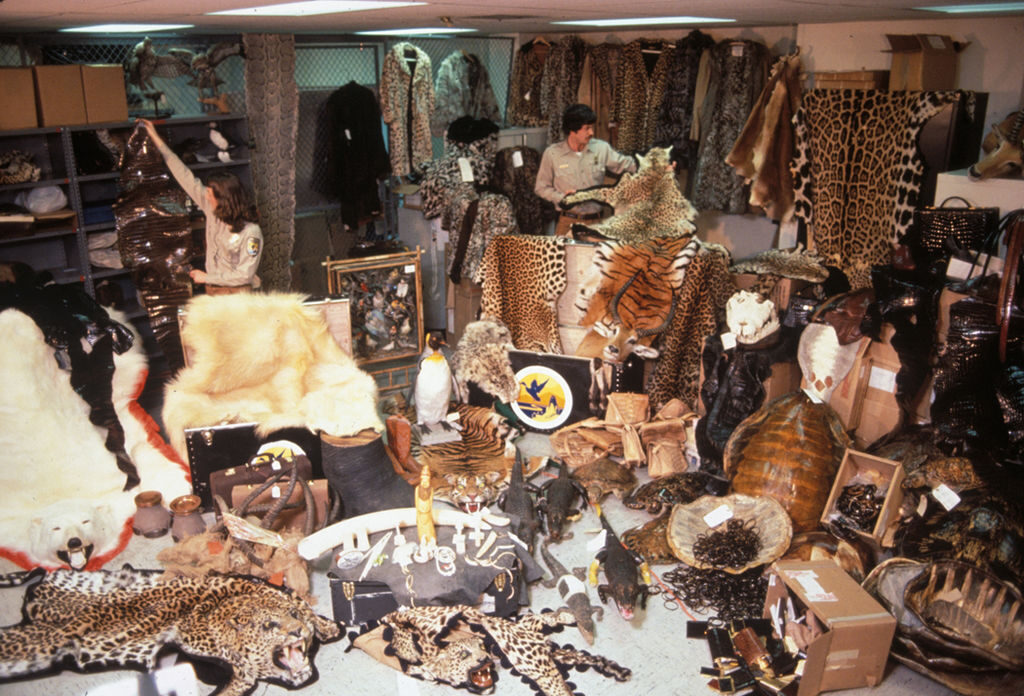
Bild: Steve-Hillebrand
Förbjudet att handla med viltfångade arter
Högst skydd mot handel har de arter som är inom kategori A och B. Här gäller oftast att handel mellan EU och övriga världen är förbjuden utan tillstånd. Arter som är CITES A eller B-klassade får inte heller köpas eller säljas inom EU om det inte kan bevisas att de har lagligt ursprung och inte fångats i det vilda.
Att använda växter eller djur för att tillverka souvenirer och annat är också förbjudet. Den som bryter mot reglerna kan dömas till böter eller fängelse.
Kontrollera spridning av arter

Arter som är CITES C-klassade är utrotningshotade i ett visst land men inte nödvändigtvis i hela världen. CITES D-klassning betyder att en art importeras i så stort antal att de behöver regleras för att inte riskera att sprida sig okontrollerat där de inte hör hemma.

What is symbiosis?
Symbiosis refers to when two different species live together. It is usually said that both species must benefit for it to be called symbiosis, but this is not really true. When both species benefit from the partnership, the symbiosis is called ”mutualistic”. A common example is symbiosis between plants and insects. Insects visit flowers and fruit trees to feed on nectar. When they crawl into the flower, they also bring pollen that sticks to their bodies or legs. Then, as they fly to the next flower of the same species, they spread pollen and help flowers and fruit trees reproduce.
A hover fly with pollen grains stuck on its body - an example of symbiosis between insects and plants.
Photo: Andre-Karwath-CC-BY-SA
A bee with filled pollen baskets on its hind legs. The cooperation between pollinating insects and plants is called mutualistic, since both plant and insect benefit from the symbiosis.
Photo: Marc-Andrighetti-CC-BY-SA
Leafcutter ants cut pieces of leaves and carry to their nest...
...to feed the fungi that the ants are cultivating in the nest. By growing tje fungi, the ants also get food.
Photo: Christian-R.-Linder-CC-BY-SA
Tree roots with mycorrhiza - a symbiotic relationship between trees and fungi.
Photo: Wilhelm-Zimmerling-CC-BY-SA
Orchids are completely dependant on symbiosis with fungi to survive.
Photo: Jose-Manuel-Lopez-Pinto-CC-BY-SA
Us humans live in symbiosis with many of the bacteria found in and on our bodies. We have bacteria in our mouths and intestines that help break down nutrients such as proteins, fats and carbohydrates. In the nose and on the skin, they protect against dangerous microorganisms.
Fungi in many partnerships
Some ants and species of fungi live in symbiosis. The leafcutter ant collects leaves for its nest. The leaves become food for the fungus that lives in the nest. The leafcutter ants in turn feed on the fungus. Plants and fungi often live in symbiosis. The roots of the plant and the fungal filaments (mycelium) exchange water and nutrients with each other. This is called mycorrhiza. Some plants, such as orchids, depend entirely on mycorrhiza for survival.
The clownfish has a protective layer of mucus on its skin, which makes it immune to the anemone's venom. The anemone is a perfect protection for the clownfish, as predators prefer to stay away from its venomous tentacles. The clownfish keeps the anemone clean by eating its leftover food, parasites, and wave fresh water over the anemone's tentacles.
Photo: Alexander-Vasenin-CC-BY-SA
Most species of pistol shrimp live in symbiosis with fish in the goby family. Because the shrimp has such poor eyesight, the fish keeps watch, while the shrimp digs out the burrow with its practical claws. Both the fish and the shrimp benefit from the collaboration.
Photo: Steve-Childs-CC-BY
The hermit crab cooperates with small sea anemones. They protect the crab from predators, and at the same time they get a ride on the shell and get a better chance of catching food.
Photo: Nick-Hobgood-CC-BY-SA
The clownfish and the anemone, the pistol shrimp and the goby
The clownfish, which you may have seen in the film Finding Nemo, lives in symbiosis with sea anemones. It is immune to the anemone’s venom, and lives protected from predatory fish that cannot tolerate this venom. The clownfish also feeds on the leftovers of the anemone’s meals. The clownfish in turn protects the sea anemone from parasites, and predators that want to eat it.
The pistol shrimp and the goby also work closely together. The pistol shrimp shovels sand from the common burrow, using its large claws. Meanwhile, the goby keeps watch. An important symbiosis for the pistol shrimp, which has poor eyesight but is an excellent shoveler, and for the goby, which is a poor shoveler, but an excellent guard!
The head louse lives as a parasite on human scalp, where it draws blood from its host.
Photo: Gilles-San-Martin-CC-BY-SA
Tape worms are parasitic worms living in the intestines of humans and other vertebrates.
Photo: Diphyllobothrium_Ta-Ntalas-CC-BY-SA
A ladybug guarding a parasitoid wasp's egg cocoon.
Photo: Gilles-San-Martin-CC-BY-SA
The tongue-eating louse is a parasitic crustation that gets inside a fish through the fish's gills, and eats the fish's tongue. By replacing the tongue with itself, the fish can continue living while the parasite eats blood and mucus from the fish.
Photo: Marco-Vinci-CC-BY-SA
An ant that died of a parasitic fungi infection.
Photo: Bernard-DUPONT-CC-BY-SA
Zombie ants and intestinal worms
Another form of symbiosis is parasitism. In this case, only one species benefits from the symbiosis, and the other is disadvantaged by being harmed, having difficulty reproducing or even dying. Some parasites are found on the outside of the body, such as lice, ticks and fleas. Others are found inside the body, such as intestinal parasites and tapeworms.
There is a parasitic wasp that lays its eggs inside ladybirds. The larvae feed on the body of the ladybird without damaging internal organs. The larvae then spin a cocoon under the ladybird and have it guard the cocoon until the larvae hatch.
There are several species of sac fungi that parasitise insects and ants. The spores of the parasitic fungus enter the ant’s body and change the ant’s behaviour so that it climbs up a tall tree where it will firmly attach itself by biting into the tree. The ant then dies and the fungus forces its way out of the ant’s body to spread its spores to new ants. The higher up the fungus releases its spores, the easier it is to infect more ants.

Common clownfish
Amphiprion ocellaris

Cooperates with the venomous anemone
Perhaps you recognise the orange and white fish swimming among the tentacles of the anemone? It’s a species known as the common clownfish, which is the fish made famous in the film Finding Nemo. The tentacles of the anemone contain nettle cells, which emit a venom that harms other fish. But not the clownfish! It has a protective layer of mucus on its skin, which makes it immune to the venom of the anemone. This makes the anemone a perfect shelter for the clownfish, as predators prefer to stay away.
But it’s not just the clownfish that benefits from the partnership. The clownfish keeps the anemone clean by eating its leftovers and any parasites, and wafting fresh water over the anemone’s tentacles. When two different species live together in a close relationship, it’s called symbiosis.

Photo: Alexander-Vasenin-CC-BY-SA
The female is in charge of the group
The common clownfish inhabits coral reefs in small groups. There is only one female in the group, and she is the largest and highest in rank. The largest male is her partner, usually for life. He is the only one allowed to reproduce. The female disturbs her male partner so much that he doesn’t grow as big as her. The rest of the fish in the group are younger or smaller males.
The large male subjects the smaller males to the same behaviour that the female subjects him to. This means that they do not get enough food to grow big either. When clownfish breed, the female lays many eggs on a rock near the anemone, which the male guards until they hatch. After spending a few days as larvae, roaming freely in the water, the fry look for their own anemone to inhabit.

Photo: Prilfish-CC-BY
Nemo’s dad should have been Nemo’s mom
All clownfish are born as, and develop into, males. The only way for a new female to develop is when the previous female in a group disappears for some reason. Then the largest remaining male changes sex and becomes the dominant female. The largest juvenile becomes the new dominant male. In the film Finding Nemo, Nemo’s mother has died. Had it been in real life, Nemo’s father would therefore have become Nemo’s new mother!
Following the film Finding Nemo, clownfish became a very popular aquarium fish. They are therefore caught in large numbers, but many beginners are unfamiliar with how to care for a saltwater aquarium. As of yet, the common clownfish is not listed as endangered on the Red List, but there are many indications that it will be in the future.
Distribution worldwide
Coral reefs in the eastern Indian Ocean and the western Pacific Ocean.
White marking = Distribution

Threat based on the Red List

Trade regulations
CITES: Not listed.

Pistol shrimp
Alpheidae sp.

A very loud sound produced by a claw
Pistol shrimps are a family of shrimps consisting of about 600 species. Common to all pistol shrimps is that one claw is greatly enlarged, and can make a pistol shot-like sound of up to 218 decibels. These are sound levels that rival those of whales, which are the loudest animals in the world. When the pistol shrimp snaps its claw together, it creates a shock wave so powerful that it can paralyse fish and other prey.

Photo: Daiju-Azuma-CC-BY-SA
Builds nests for protective fish
The pistol shrimp has a very hard shell, long antennae on its head and 10 legs. If it loses its large claw, the smaller one grows into a large claw. If it loses its small claw, it grows a new one. Pistol shrimps have very poor eyesight, with small eyes covered by the dorsal shield.
Pistol shrimps are bottom-dwelling and dig burrows in the sand, preferably under rocks or coral reefs. Most species of pistol shrimp live in symbiosis with fish of the Gobiidae family, or gobies. Since the shrimp has such poor eyesight, the fish stands guard while the shrimp digs out the burrow with its practical claws. Both the fish and the shrimp benefit from the cooperation.

Photo: Nhobgood-Nick-CC-BY-SA
May have two sexes
Some species of pistol shrimp are hermaphrodites – that is, the same individual can be both male and female, while other species of pistol shrimp have both distinct males and females. A pair of pistol shrimp can stay together for life, and even hermaphroditic species form pairs and develop into a male and a female within the pair. Pistol shrimps lay their eggs in chambers in the burrows they dig.
Distribution worldwide
Eastern Pacific in coral reefs around the equator.

Threat based on the Red List

Trade regulations
CITES: Not listed.

Jewelled Blenny
Salarias fasciatus

Eats decayed animals
The jewelled blenny belongs to the combtooth blennies, and the name blenny is derived from a Greek word for ‘mucus’ or ‘slime’. Indeed, the blennies are covered in a thick film of mucus, allowing the fish to survive out of the water for short periods of time.
The jewelled blenny grazes algae, but it also eats faeces and decayed parts of dead animals. The species inhabits coral reefs, often in shallow lagoons and stagnant water, close to sandy bottoms. The fish lives alone or in pairs. Its colour adapts to the environment and the fish can change colour to hide from predators.

Photo: Dirk-Godlinski-CC-BY-SA
The females attach their eggs to plants
Adult male jewelled blennies have an elongated anal fin. They aggressively defend their territory, and outside of the breeding season they are aggressive towards females as well. But during the breeding season, the male develops orange spots on his dorsal fin, and he “dances” in front of the female. He extends his fins and rocks from side to side.
The female lays her eggs so they attach to plants growing on rocks or directly from the bottom, and the male fertilises the eggs there. The species is a popular aquarium fish that likes to graze algae from the tank decorations and glass.

Photo: zsispeo-CC-BY-NC-SA
Distribution worldwide

From East Africa to Indonesia, Fiji, the Solomon Islands, south of the Great Barrier Reef.
Threat based on the Red List

Trade regulations
CITES: Not listed.

Bristle-tail Filefish
Acreichthys tomentosus

The skin is rough and can change colour
The bristle-tail filefish belongs to the filefish family, which has been named after its compact body and its skin texture, which resembles sandpaper. The fish can change colour depending on its environment, which helps it to avoid predators. It is a shy species that lives in shallow tropical waters among seaweed. The bristle-tail filefish is a popular aquarium fish, mainly because it likes to eat glass rose anemones, a kind of sea anemone that often causes problems in aquariums. The filefish is therefore a useful animal that helps keep the tank clean.

Photo: Ellika-Nordström-Malmö-Museer
A spine on the back
The bristle-tail filefish has a characteristic appearance with a pronounced spine and skin flap on its dorsal fin. The spine can be erected, making the fish appear bigger. The male erects the spine both against other males and to attract a partner. A female can lay several hundred eggs that she defends from other fish. When the eggs have hatched the fry are left on their own.

Photo: krokodiver-CC-BY-SA
Distribution worldwide

Mainly the Indian Ocean and western Pacific Ocean.
Threat based on the Red List

Trade regulations
CITES: Not listed.

Stony corals

The foundation for coral reefs
Stony corals have hard skeletons, which they build from the calcium they absorb from seawater. Corals depend on high levels of calcium in the water in order to develop sturdy skeletons. Corals live in the oceans across large parts of the world. They are most common in tropical waters, but also inhabit the Swedish waters off Bohuslän.
Stony corals play an important role in the building of coral reefs, as they form hard calcareous skeletons that remain even after the coral has died. Stony corals come in many different shapes, such as branching, rounded, disc-shaped or lumpy. For example, stony corals living in colonies may resemble a brain or moose antlers.
The hard skeleton of the stony corals are what makes the foundation of the world's coral reefs.
Photo: Toby-Hudson-CC-BY-SA
The coral reefs have lots of hiding places for many different species.
Photo: Nick-Hobgood-CC-BY-SA
Acropora corals can resemble antlers of deers.
Photo: MDC-Seamarc-Maldives-CC-BY-SA
A stony coral with a surface that resembles a brain.
Photo: Ryan-McMinds-CC-BY
There are many different structures of stony corals.
Photo: Ryan-McMinds-CC-BY
Stony corals can grow like bracket fungi, or large patches of lichen.
Photo: Williams-et-al.-CC-BY
The hard calcium skeleton of the anemone coral hides under its long, soft tentacles.
Photo: Bernard-DUPONT-CC-BY-SA
Fungia corals in Indonesia.
Photo: Bernard-DUPONT-CC-BY-SA
A species of cold water coral with an astonishing way of growing. It lives on depths down to 1,500 meters.
A stony coral growing in a round, lumpy way.
Photo: Diego-Delso-CC-BY-SA
Algae are common inhabitants
Stony corals belong to the class Anthozoa, and there are about 2,500 species. A coral is usually a whole colony of small polyps, each of which is a separate individual – often copies of each other. Polyps have a sack-like body protected by an outer calcareous skeleton. Stony corals usually, but not always, live in large colonies.
Many species of stony corals live in symbiosis with so-called zooxanthellae, a type of single-celled algae. Zooxanthellae live inside the polyps. They contribute to the energy supply of the coral and depend on sunlight penetrating deep into the water to survive. Stony corals in colonies are harder and more resilient than those living alone. But the stony corals that live alone can be found as deep as 6,000 metres! Deep-dwelling corals get their food from eating plankton that float by in the water.
Each polyp is an individual animal, together creating a coral colony.
Photo: Peter-Young-Cho-CC-BY-SA
The coral polyp's mouth is located in the middle of the animal.
Photo: Justin-Casp-CC-BY-SA
Small, partly extracted polyps.
Photo: David-Witherall-and-Pete-Morrison-CC-BY
Tiny polyps with even smaller tentacles.
Photo: Narrissa-Spies-CC-BY-SA
A recently attached polyp. The brown dots are the inhabitant algae of the coral - zooxanthellae.
Photo: Narrissa-Spies-CC-BY-SA
The most common algae living inside corals are zooxanthellae. The photo shows zooxanthellae seen through a microscope.
Photo: Tim-Wijgerde-CC-BY-SA

Sea anemones
Actiniaria

Animals that resemble mushrooms or plants
Sea anemones may look like plants or mushrooms, but they are an order of aquatic animals within the group of cnidarians. The cnidarians also include the relatives of the anemone, such as corals and jellyfish. Sea anemones range in size from 5 mm to 100 mm in diameter, and can have many different colours, such as red, pink, yellow, white, orange, green, blue and brown.
Most sea anemones inhabit the tropical reefs, but there are some species that have also adapted to colder waters with sandy environments and tidal reefs. There are about 1,200 species of anemones worldwide, and about 30 of these can be found along the west coast of Sweden.
Sea anemones can resemble flowers under water.
Sea anemones are recognized by their long tentacles. They are covered in nettle, or stinging, cells, which are used to paralyze and catch prey.
Photo: Sergey-Galyonkin-CC-BY-SA
Green anemone with purple tips.
Sea anemones can be black.
A purple sea anemone.
A sea anemone with "bubbles" in the tips of its tentacles.
Photo: Blowing-Puffer-Fish-CC-BY
Tiny anemones called strawberry anemones.Små anemoner som kallas jordgubbsanemoner.
Photo: Peter-Southwood-CC-BY-SA
Sea anemones can have a striped pattern.
Photo: Peter-Southwood-CC-BY-SA
Red sea anemones with retracted tentacles during low tide. This species lives along the coast of Norway.
Photo: O.-Nevestveit-CC-BY-SA
Sagartiogeton laceratus is a species of sea anemone living in Swedish water, along the west coast.
Photo: Mike-Noren-CC-BY-SA
Eats and poops through the same hole
Anemones are shaped like something known as a polyp. They have a cylinder (tube) form, consisting of a body, a foot and a crown with tentacles. In the body there is a cavity, like a sack, which acts as the stomach of the anemone. An opening which serves as both mouth and anus leads to the stomach. The many tentacles of the anemone move back and forth in the water. The tentacles are covered with burning nettle cells that protect against predators, and paralyse and capture prey such as shrimps and plankton. The tentacles are used to move food to the mouth.
The foot disc at the base of the anemone’s body is used to attach to rocks, seaweed or similar near the bottom. A few species, however, are completely free-swimming in the water. The foot disc does not remain attached to the substrate, allowing the anemone to move. Movement, however, is extremely slow.
The sea anemone's mouth is located in the centre of the animal. The mouth is the same hole as the anus, used both for eating and pooping.
Photo: Daniel-Ankele-CC-BY-SA
The sea anemone's tentacles carry its stinging cells, which are able to burn and paralyse preys.
Photo: prilfish-CC-BY
A small fish captured and eaten by a sea anemone.
The sea anemone can use its stinging nettle cells to fight other anemones or corals, in order to get the best growing spot. The photo shows to anemones with burns on their tentacles.
Photo: Seascapeza-CC-BY-SA
The species "wandering sea anemone" is extra movable, and can "wander" around on the sea floor in search of the best spot.
Photo: Peter-Southwood-CC-BY-SA
The underside of a sea anemone's foot against the glass in an aquarium.
Photo: Betty-Wills-CC-BY-SA
Sea anemones can reproduce by releasing sperm and eggs in the water - or by budding, which means letting go of a body part, which grows into a new individual.
Sea anemones camouflaging themselves with grains of sand.
Stinging tentacles benefit other species
Many anemones live in symbiosis, meaning cooperation, with other species such as fish, crabs and algae. Fish are protected from predators by the stinging tentacles of the anemones. The clownfish species, famous from the film Finding Nemo, has developed a special mucus layer in its skin that protects it from the venom-lined tentacles of the anemones. The anemones benefit from getting access to food, by eating bits of small fish, algae and worms left as scraps by the clownfish.
An anemone living in symbiosis with a crab, attaches itself to the shell of the crab with the help of its foot disc. The anemone protects the crab from predators and in return receives food by eating the scraps left by the crab, such as mussels, fish, shrimp and jellyfish.
Many species of clownfish have a close teamwork with sea anemones. The fish is immune towards the anemone's toxin, and gets the perfect hiding spot.
Photo: Rizalubun-CC-BY-SA
This hermit crab cooperates with small sea anemones. They protect the crab against predators, and at the same time the anemones get a quick ride on the crab's shell, and have a better chance of catching food.
Photo: Nick-Hobgood-CC-BY-SA

Sand star
Archaster typicus

Eyes in arms and stomach on the outside of the body
When feeding, starfish wrap their arms around their prey, for instance a mussel, and pry it open. The digestive system of the starfish is simple, and the mouth is on its underside. When eating a larger catch, the starfish can eject its stomach outside its body to capture and even digest the prey, still with its stomach outside its body.
If any of the arms of the starfish are lost, a new one will grow out. At the end of each arm, the starfish has an eye. The eyes can distinguish differences in light. Each arm also has a gonad, which produces reproductive cells and sex hormones. Starfish do not have a centralised brain, but they do have an advanced nervous system and are sensitive to touch. The heart of a starfish beats only about six times a minute.

Photo: Anne-Hoggett-CC-BY
An echinoderm
Starfish belong to the phylum Echinodermata. There are 2,000 species in total, including sea urchins, brittle stars and starfish such as the sand star. The sand star usually have five arms, but may have more or fewer. They are often partially buried in the sand. The species has declined in numbers, and in the early 2000s a large number died off Singapore, due to habitat loss and excessive fishing.

Photo: budak-CC-BY-NC
The male lies on the back of the female for months
Most starfish reproduce by simply releasing eggs and sperm freely into the water, without any actual physical contact between the male and the female. But sand stars are a little different! The male, which is smaller than the female, seeks out a female during the mating season and lays on top of her. He can stay in that position for up to two months! When it’s time to mate, they wrap their arms around each other. Their genitals do not meet, but the male releases sperm and the female eggs, which are then fertilised freely in the water. The young grow up among sea grass and roots above the seabed, near sandy beaches.

Photo: budak-CC-BY-NC
Distribution worldwide
The Pacific.

Threat based on the Red List

Trade regulations
CITES: Not listed.

What is the Red List?
The Red List is a way to assess whether different animal and plant species are at risk of extinction based on criteria such as how many animals or plants of a species exist and how widely distributed they are. A national Red List assesses a species’ risk of dying out within national borders. The international Red List assesses a species’ risk of dying out worldwide.
Read more

About the Red List in Sweden: The Swedish Species Information Centre (Artdatabanken), www.artdatabanken.se/en/
About the Red List worldwide: The International Union for Conservation of Nature (IUCN), www.iucn.org

What is CITES?
CITES (the Convention on International Trade in Endangered Species of Wild Fauna and Flora) is a treaty that makes it illegal to buy or sell animals and plants that are at risk of extinction between countries without a permit.
CITES classifies species into different categories (called Appendix I, II and III) depending on how endangered each species is. In addition, the more the species is threatened by international trade, the higher its level of protection. Within the EU, CITES-listed species are further classified and protected by the EU’s own classification system. This has four Annexes, from A to D.

Photo: Steve-Hillebrand
Ban on trading wild-caught species
The highest protection against trade is given to CITES-listed species included in the EU’s Annexes A and B. Usually this means that trade between the EU and the rest of the world is illegal without a permit. There is also a ban on trading these species within the EU unless it can be proved that they have a lawful origin and were not caught in the wild.
It is also forbidden to use plants or animals to make souvenirs etc. Anyone who breaks these regulations can be fined or imprisoned.
Controlling the spread of species

CITES-listed species that are in the EU’s Annex C are classified as endangered in at least one country but not necessarily in the whole world. An Annex D classification means that individual members of a species may be imported to the extent that they do not need to be regulated to avoid any risk of them spreading uncontrollably where they do not belong.
